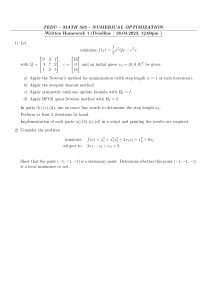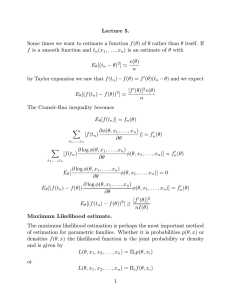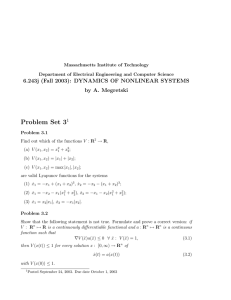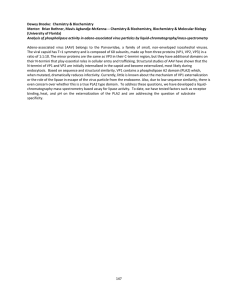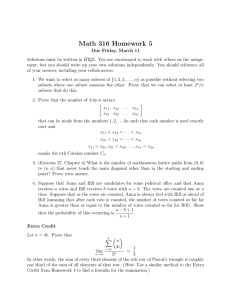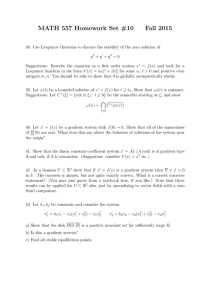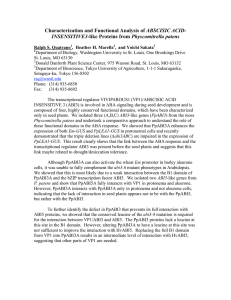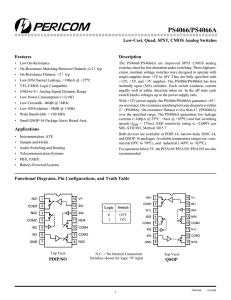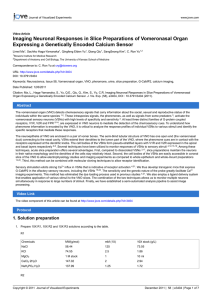Math 5080–1 Solutions to homework 7 July 19, 2012
advertisement
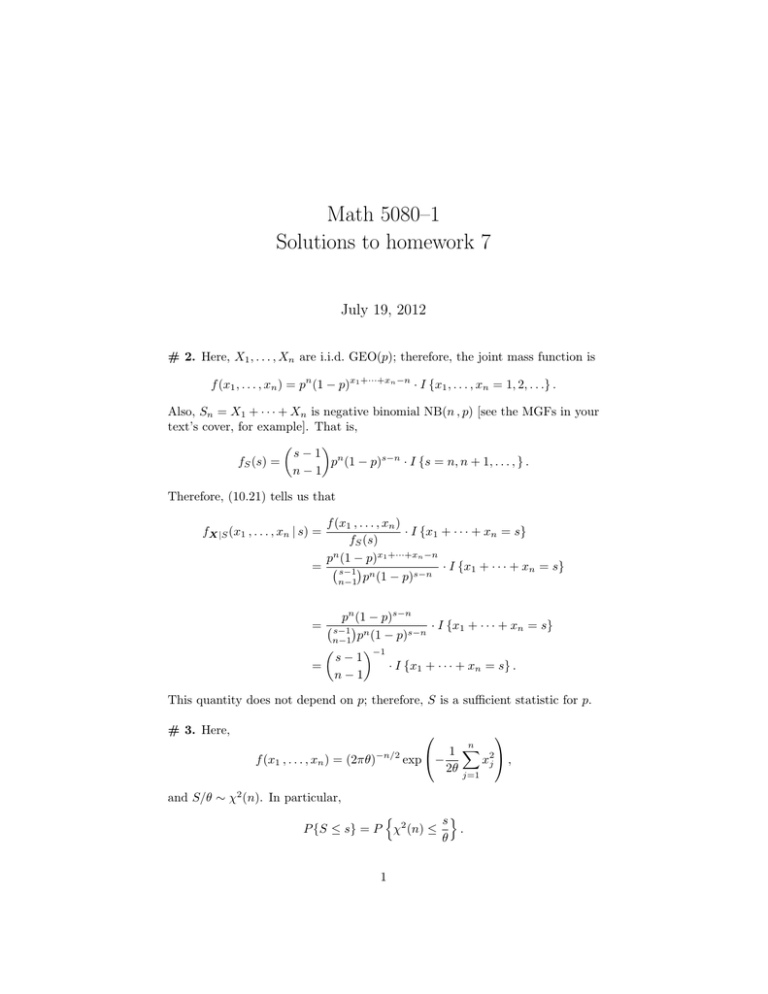
Math 5080–1
Solutions to homework 7
July 19, 2012
# 2. Here, X1 , . . . , Xn are i.i.d. GEO(p); therefore, the joint mass function is
f (x1 , . . . , xn ) = pn (1 − p)x1 +···+xn −n · I {x1 , . . . , xn = 1, 2, . . .} .
Also, Sn = X1 + · · · + Xn is negative binomial NB(n , p) [see the MGFs in your
text’s cover, for example]. That is,
s−1 n
fS (s) =
p (1 − p)s−n · I {s = n, n + 1, . . . , } .
n−1
Therefore, (10.21) tells us that
f (x1 , . . . , xn )
· I {x1 + · · · + xn = s}
fS (s)
pn (1 − p)x1 +···+xn −n
= s−1 n
· I {x1 + · · · + xn = s}
s−n
n−1 p (1 − p)
fX|S (x1 , . . . , xn | s) =
pn (1 − p)s−n
· I {x1 + · · · + xn = s}
s−1 n
s−n
n−1 p (1 − p)
−1
s−1
=
· I {x1 + · · · + xn = s} .
n−1
=
This quantity does not depend on p; therefore, S is a sufficient statistic for p.
# 3. Here,
n
X
1
f (x1 , . . . , xn ) = (2πθ)−n/2 exp −
x2 ,
2θ j=1 j
and S/θ ∼ χ2 (n). In particular,
n
so
P {S ≤ s} = P χ2 (n) ≤
.
θ
1
Differentiate both sides (d/ds) to see that
1
fS (s) = fχ2 (n) (s/θ) ×
θ
s (n/2)−1
1
1
= n/2
e−s/(2θ) × .
θ
2 Γ(n/2) θ
It follows from (10.21) that
f (x1 , . . . , xn )
· I x21 + · · · + x2n = s
fS (s)
Pn
1
2
(2πθ)−n/2 exp − 2θ
j=1 xj
=
· I x21 + · · · + x2n = s
(n/2)−1
1
s
e−s/(2θ) × θ1
2n/2 Γ(n/2) θ
fX|S (x1 , . . . , xn | s) =
=
Γ(n/2)
· I x21 + · · · + x2n = s .
π n/2 s(n/2)−1
This does not depend on θ; therefore, S is sufficient for θ.
# 4. First of all,
f (x1 , . . . , xn ) = e−
Pn
j=1 (xj −η)
· I {x1:n > η} .
Now we work on the distribution of S = X1:n . Since
n
P {S ≤ s} = 1 − (P {X1 > s}) = 1 − (1 − F (s))
n
for all s,
we differentiate both sides (d/ds) to see that
fS (s) = n (1 − F (s))
n−1
f (s).
Since f (x) = e−(x−η) · I{x > η},
Z s
F (s) =
e−(a−η) da = 1 − e−(s−η)
if s > η.
η
If s ≤ η then F (s) = 0. Therefore,
fS (s) = ne−n(s−η) · I{s > η} ⇒ S ∼ DE(n , η)
And by (10.21),
fX|S (x1 , . . . , xn | s) =
=
=
f (x1 , . . . , xn )
· I {x1:n = s}
fS (s)
e−
Pn
e−
Pn
j=1 (xj −η)
· I {x1:n > η}
· I {x1:n = s}
ne−n(s−η) · I{s > η}
j=1 (xj −s)
· I {x1:n = s} .
n
2
This quantity does not depend on η.
# 6. The joint mass function of our data is
n Y
mi xi mi −xi
f (x1 , . . . , xn ) =
p q
· I {xi = 0 , . . . , mi for all i = 1, . . . , n}
xi
i=1
Pn
= Cp
where C :=
Qn
i=1
mi
xi
i=1
xi
q
Pn
i=1 (mi −xi )
. That is,
Pn
f (x1 , . . . , xn ) = C 0 (p/q)
where C 0 := Cq
Pn
i=1
· I {xi = 0 , . . . , mi for all i = 1, . . . , n} ,
mi
xi
i=1
· I {xi = 0 , . . . , mi for all i = 1, . . . , n} ,
. The factorization theorem does the rest for us.
# 7. Let us apply the factorization theorem. The joint mass function is
n Y
xi − 1 ri xi −ri
f (x1 , . . . , xn ) =
p q
· I {xi = r1 , r1 + 1, . . . for all i ≤ n}
ri − 1
i=1
= Cq
where C :=
Qn
i=1
Pn
i=1
xi −1
ri −1
xi
· I {xi = r1 , r1 + 1, . . . for all i ≤ n} ,
(p/q)ri . Therefore, S :=
Pn
i=1
Xi is sufficient for p.
# 16. The likelihood function is
L(p) =
n Y
Xi − 1
ri − 1
i=1
pri q Xi −ri ,
therefore, the log-likelihood function is
n
n
n
X
X
X
Xi − 1
ln L(p) =
log
+ ln p
ri + ln(1 − p)
(Xi − ri ).
ri − 1
i=1
i=1
i=1
Therefore,
d
ln L(p) =
dp
Pn
i=1 ri
p
Pn
−
− ri )
.
1−p
i=1 (Xi
Set this equal to zero in order to see that the usual MLE of p is
Pn
Pn
ri
ri
i=1
Pn
= Pni=1 .
p̂ = Pn
i=1 ri
i=1 (Xi − ri ) +
i=1 Xi
Pn
Now let us maximizePthe mass function of S := i=1 Xi . Examine the MGF’s
n
to see that S ∼ NB( i=1 ri , p). Therefore,
(
)
P
n
X
Pn
n
s−1
fS (s) = Pn
p i=1 ri q s− i=1 ri · I s ≥
ri .
i=1 ri − 1
i=1
3
The corresponding likelihood function
P
Pn
n
S−1
LS (p) = Pn
p i=1 ri q S− i=1 ri ,
i=1 ri − 1
whose log is
n
X
S−1
P
+ ln p
ln LS (p) = ln
ri +
n
i=1 ri − 1
i=1
This yields
!
ri
ln(1 − p).
i=1
Pn
S − i=1 ri
−
.
p
1−p
Pn
Set the preceding to zero to see that p̂ = i=1 ri /S, as before. So the answer
is “yes,” the two procedures yield the same MLE.
d
ln LS (p) =
dp
Pn
S−
n
X
i=1 ri
4
